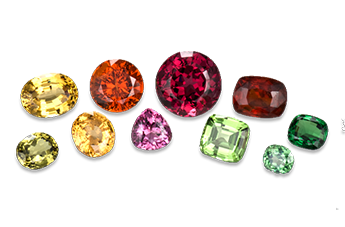GARNET
Garnet is a group of related gem species that is best known for its red varieties. People don't realize, however, that garnet forms in many colors of the rainbow. Beside the red almandite and pyrope, and the purplish red rhodolite, there is pinkish orange Malaya and orange spessartite with a color potentially so pure that it may deserve the varietal name mandarin. One must not overlook the yellow Mali garnet, the yellowish brown to orange hessonite and the brilliant green tsavorite and demantoid. The only spectral hue not displayed by garnet is blue. There are even color change varieties, displaying different colors in incandescent and fluorescent light. Garnets have been found all over the world and discovered throughout history. Pyrope and almandite were once as sought after as ruby. The ancient Greeks and Romans associated these gems with fire and Noah is said to have used a garnet lantern to guide his ark. But many of the garnets have been discovered quite recently. Demantoid was first found in the Ural Mountains of Russia in 1868. Tsavorite was discovered on the border of Kenya and Tanzania in 1967, Mandarin garnet appeared first in Namibia in 1991 and Mali garnet a few years after that.

Image Above: The garnet species and varieties vary significantly in availability with almandite being the most common and demantoid the most rare, particularly in sizes over 2 carats. Of course, the price of the various garnets tends to increase in relation to an increase in rarity. In addition to their range of color, garnets are not generally treated. Most are quite durable, with a hardness of 7 to 7.5 and fair to good toughness but are sensitive to sudden changes in temperature. Steam cleaners should, therefore, not be used. It's not surprising that garnet was chosen as the January birthstone and 2nd anniversary wedding anniversary gem.

